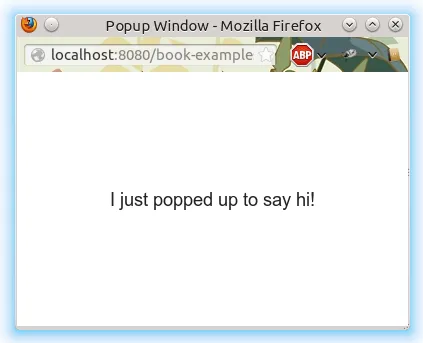Handling Browser Windows
The UI of a Vaadin application runs in a web page displayed in a browser window or tab. An application can be used from multiple UIs in different windows or tabs, either opened by the user using an URL or by the Vaadin application.
In addition to native browser windows, Vaadin has a Window component, which is a floating panel or sub-window inside a page, as described in "Sub-Windows".
-
Native popup windows. An application can open popup windows for sub-tasks.
-
Page-based browsing. The application can allow the user to open certain content to different windows. For example, in a messaging application, it can be useful to open different messages to different windows so that the user can browse through them while writing a new message.
-
Bookmarking. Bookmarks in the web browser can provide an entry-point to some content provided by an application.
-
Embedding UIs. UIs can be embedded in web pages, thus making it possible to provide different views to an application from different pages or even from the same page, while keeping the same session. See "Embedding UIs in Web Pages".
Use of multiple windows in an application may require defining and providing different UIs for the different windows. The UIs of an application share the same user session, that is, the VaadinSession object, as described in "User Session". Each UI is identified by a URL that is used to access it, which makes it possible to bookmark application UIs. UI instances can even be created dynamically based on the URLs or other request parameters, such as browser information, as described in "Loading a UI".
Because of the special nature of AJAX applications, use of multiple windows uses require some caveats.
Opening Pop-up Windows
Pop-up windows are native browser windows or tabs opened by user interaction with an existing window. Due to browser security reasons, it is made inconvenient for a web page to open popup windows using JavaScript commands. At the least, the browser will ask for a permission to open the popup, if it is possible at all. This limitation can be circumvented by letting the browser open the new window or tab directly by its URL when the user clicks some target. This is realized in Vaadin with the BrowserWindowOpener component extension, which causes the browser to open a window or tab when the component is clicked.
The Pop-up Window UI
A popup Window displays an UI. The UI of a popup window is defined just like a main UI in a Vaadin application, and it can have a theme, title, and so forth.
For example:
Source code
Java
@Theme("mytheme")
public static class MyPopupUI extends UI {
@Override
protected void init(VaadinRequest request) {
getPage().setTitle("Popup Window");
// Have some content for it
VerticalLayout content = new VerticalLayout();
Label label =
new Label("I just popped up to say hi!");
label.setSizeUndefined();
content.addComponent(label);
content.setComponentAlignment(label,
Alignment.MIDDLE_CENTER);
content.setSizeFull();
setContent(content);
}
}Popping It Up
A popup window is opened using the BrowserWindowOpener extension,
which you can attach to any component or MenuItem. The constructor of the extension takes
the class object of the UI class to be opened as a parameter.
You can configure the features of the popup window with setFeatures(). It takes as its parameter a comma-separated list of window features, as defined in the HTML specification.
- status=0|1
-
Whether the status bar at the bottom of the window should be enabled.
- [parameter]##
- scrollbars
-
Enables scrollbars in the window if the document area is bigger than the view area of the window.
- resizable
-
Allows the user to resize the browser window (no effect for tabs).
- menubar
-
Enables the browser menu bar.
- location
-
Enables the location bar.
- toolbar
-
Enables the browser toolbar.
- height=value
-
Specifies the height of the window in pixels.
- width=value
-
Specifies the width of the window in pixels.
For example:
Source code
Java
// Create an opener extension
BrowserWindowOpener opener =
new BrowserWindowOpener(MyPopupUI.class);
opener.setFeatures("height=200,width=300,resizable");
// Attach it to a button
Button button = new Button("Pop It Up");
opener.extend(button);The resulting popup window, which appears when the button is clicked, is shown in A Popup Window.

Popup Window Name (Target)
The target name is one of the default HTML target names ( _new, _blank, _top, etc.) or a custom target name. How the window is exactly opened depends on the browser. Browsers that support tabbed browsing can open the window in another tab, depending on the browser settings.
Closing Popup Windows
Besides closing popup windows from a native window close button, you can close them programmatically by calling the JavaScript close() method as follows.
Source code
Java
public class MyPopup extends UI {
@Override
protected void init(VaadinRequest request) {
setContent(new Button("Close Window", event -> {// Java 8
// Close the popup
JavaScript.eval("close()");
// Detach the UI from the session
getUI().close();
}));
}
}